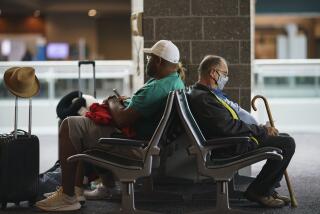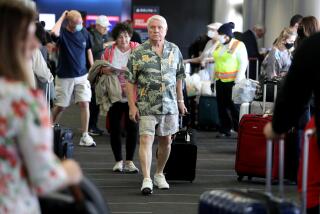Air travel with a cold is generally...
- Share via
Air travel with a cold is generally safe--if you can breathe through your nose and have no earache or sinus headache.
To reduce discomfort and to prevent earaches, do the following:
--Take a decongestant an hour before takeoff and, on long flights, every four hours.
--Chew gum during ascent and descent.
--Use a nasal spray. Use the spray 10 minutes before ascent and descent, and repeat every 10 minutes for no more than three doses. Repeat every four hours.
--Never sleep during descent. Sleep decreases the frequency of swallowing, and swallowing helps maintain equal pressure between the inner ear and the outside. This helps avoid pain.
--Avoid air travel for 24 hours after scuba diving.
Side Effects Sharper
Decongestants can cause sleepiness, dizziness and inability to concentrate. Such side effects are more severe on airplanes than at sea level. Smoking, drinking and taking other medications intensifies these symptoms. Never drive a car immediately after flights on which you used a decongestant.
--Minimize fatigue before flights. Get to the airport rested.
--Do not allow air travel to interfere with your eating schedule. The incidence of headaches increases when you fast more than five hours during the day and more than 13 hours overnight.
Low oxygen and high carbon dioxide levels cause headaches. Ask flight attendants to turn up ventilation equipment.
When your headache is associated with a hacking cough, the cause may be ozone in the cabin air. On some aircraft, ozone is sucked in through ventilation valves from the outside. It is most common on winter flights over the North Atlantic. To counteract, breathe through a wet towel for 10 minutes.
Aspirin or Ice
Treatments for headaches: Ask flight attendants for aspirin, acetaminophen (such as Tylenol or Anacin 3) or ibuprofen (Advil). Apply ice to your temples. If the headache is severe, ask for oxygen. Inhale slowly a few times. Prolonged breathing of oxygen will not give further relief.
Analgesics and ice also relieve toothaches. Apply the ice to your cheek next to the tooth that hurts.
When possible, avoid dental treatment just before air travel. This will prevent aerodontalgia, or fliers’ toothache, pain resulting from atmospheric decompresssion. Air Force dentists recommend not flying for three days after extensive dental work.
-- -- --
Healthy newborns can fly as soon as they are released from the hospital. Low cabin oxygen presents no problem.
Offer infants bottles of milk or water during ascent and descent to minimize ear problems. On long flights, offer bottles frequently to prevent dehydration.
Children being treated for uncomplicated ear infections may fly once there is no longer any pain.
Care With Hot Drinks
Never hold hot drinks while holding a small child. Tell your seat companion to be careful. Sudden movements by children have resulted in drinks being spilled and burning children. Also, do not give children hard candies and lollipops during a flight. In case of turbulence, they can lodge in the throat.
Some airlines insist that you strap small children into your seat belt, others say you must hold them on your lap without strapping them in. All agree that the safest method is an approved restraint device strapped into a separate seat. Some car seats are approved.
Using a child’s seat restraint costs an additional full fare or reduced child’s fare. Generally, airlines do not provide the safety devices.
-- -- --
Three to four hours into a flight, air conditioning has removed practically all of the moisture from the cabin air. This dries out the surface of the eyes and causes a burning sensation. The dryness is especially troublesome to contact-lens wearers.
Carry eye drops if you have sensitive eyes or if you wear contact lenses. Use the drops every few hours. Keep air-conditioning vents turned off or away from your face.
If possible, do not wear your contact lenses on flights. And never remove or insert contacts during flight. Many travelers have lost their lenses that way.
More to Read
Sign up for The Wild
We’ll help you find the best places to hike, bike and run, as well as the perfect silent spots for meditation and yoga.
You may occasionally receive promotional content from the Los Angeles Times.






